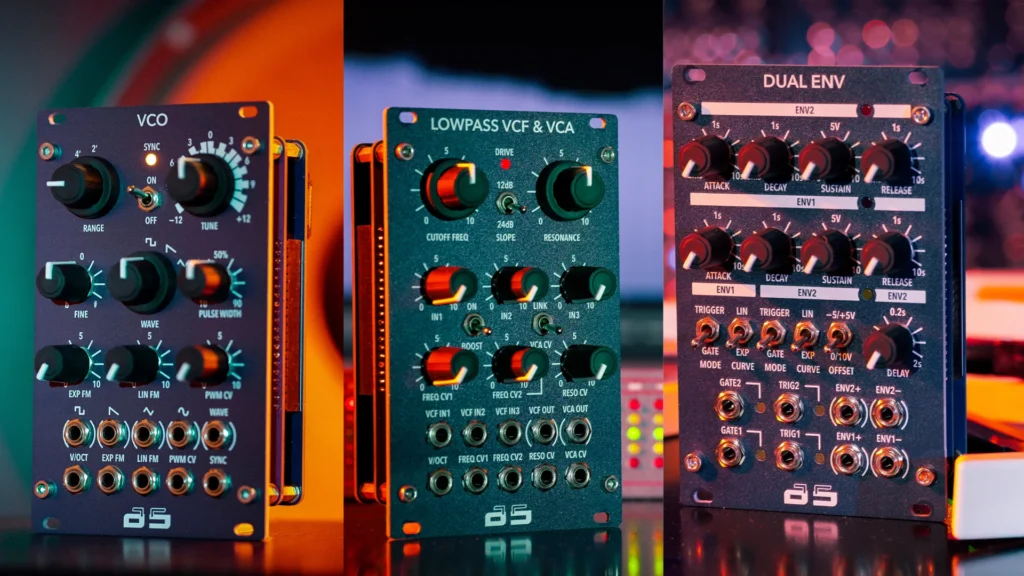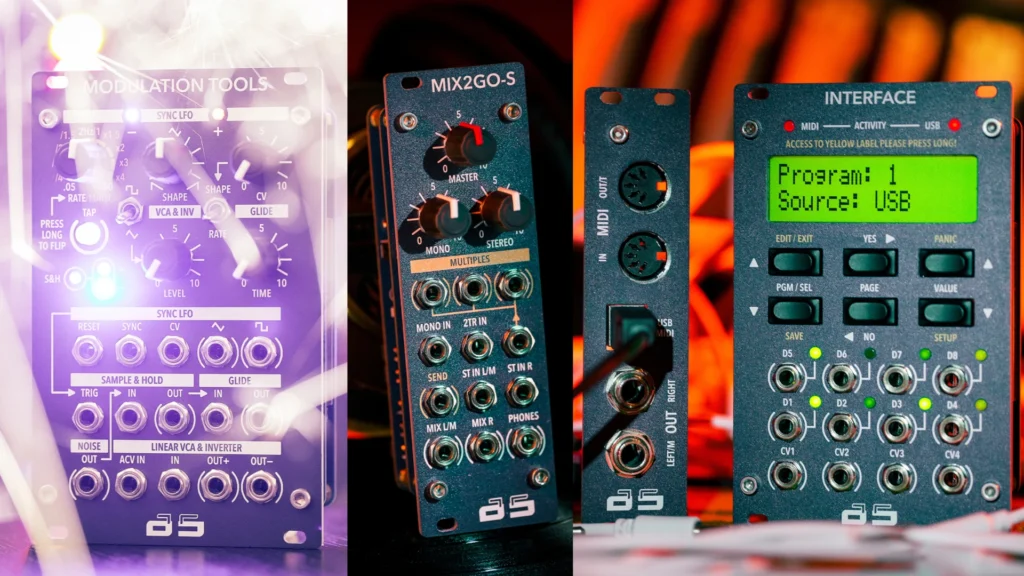AS Synthesizers from Hungary is a fresh face on the Eurorack synthesizer development front, starting with the flexible System One modules.
There are many Eurorack manufacturers. They come from all over the world. Every year new ones are added, and many leave the stage again. The Superbooth 23 in Berlin showed that constantly new developers start the Eurorack adventure. Not only there shows the news from Hungary.
There, quietly and without much outcry, a new company was founded called AS Synthesizers, which has been working on a number of new modules. These modules are now finished and ready to hit studios.
Company
AS Synthesizers was founded by Adam Miski, a musician and electrical engineer, in 2018. He started to build and construct modules for personal use. The development of the first modules with the purpose of commercial use started in 2020.
Prima
It starts with a beautiful-looking complete system called Prima with 104HP featuring an entire synth voice ready to use. You can buy the modules individually and use them in your existing Eurorack system or in the system.
All AS Synths modules share a special feature. According to the developers, the front panel jacks are accessible from the back side of the modules via jumpers. This allows you to normalize the system and create a soft-wired semi-modular Synthesizer. You can then break this connection by simply patching cables in the sockets Like you know from a classic semi-modular synth.
A very clever approach as it appeals to both modular and semi-modular synth users at the same time. So you can build a complete system that s standalone, but they leave the option to the users to go completely modular if they want.
The Prima system consists of a mono/stereo mixer, an advanced MIDI to CV interface, modulation tools, two VCOs, a lowpass VCF and VCA combo, and a versatile dual envelope. The system has a 100% analog signal path and uses digital technology for control only.
AS Synthesizers Modules: VCO, VCF, VCA & Dual ENV
As already mentioned, you can also buy the modules individually. In the beginning, there will be 6 new modules. Five interesting, and a passive multiple.
The AS Synths VCO is a through-zero analog oscillator based on a high-stability saw core. According to the developers, the level of the symmetrical waveform output is 10Vpp and is DC-connected so no capacitors are involved. The VCO covers the frequency range of 10 octaves and offers adjustable PWM, linear FM, exponential FM, and sync input, all with dedicated potentiometers. There are also individual outputs for the waveforms and for the main output.
Then, the next module is a modern VCF and VCA combo driven by a lowpass filter width switchable 12dB/oct and 24dB/oct slope and Q-compensation. The latter prevents the signal from thinning out at high resonance. As you know from the Minimoog. AS Synths says that you can achieve a band-pass filter by turning the Q-compensation off in the 12dB/octave mode. You can also add extra harmonics by overdriving the filter.
Connection side, the module hosts an audio and CV mixer with three controllable audio inputs and adjustable CV inputs for the frequency (2x) and resonance. Plus, you get the functionality of a full VCA.
The dual envelope (DUAL ENV) module consists of two envelopes, an ADSR and a DADSR envelope equipped with the all extensive CV scale 10V full range outputs. Modes and curves can be switched separately.
It also gives you the option to work with two-time sections: either in the low range from 2ms to 1s or in the range from 1s to 1os. The envelopes are not loopable, which is a bit pity.
Modulations & Mixing
Let’s continue with other modulation sources. The Modulation Tools module is a multi-function module with various tools. The core is a sync multi-wave LFO along with a noise generator, S&H, and glide generator. Plus, you get an adjustable & CV controllable VCA and an inverter. All these function can operate together or separately.
The Sync LFO has a unique function. It has a divider mode making it possible to control the rhythm of the modulation with Note CV, thus giving us the opportunity to change the rhythm of the modulation as we wish: in sync and tempo of the music, by using a keyboard or a sequencer.
Further, you can find in the young portfolio a compact, versatile mixer called MIX2GO. It has five channels and supports both modular and linear signals (line/guitar). It consists of a controllable mono, a controllable stereo, and a unity gain stereo. That’s not all. The mono channel has a volume-dependent effect send with an included high-pass filter.
I/O side, you can find stereo out on L/R mono jacks, as well as a headphone output. Plus, you get a 1-into-3 passive multiple.
Interface
Last but not least, AS Synths also introduced Interface, a flexible USB to MIDI, USB to CV and MIDI to CV interface. It hosts four programmable analog (16-bit DA converters) and eight digital outputs that can transmit a wide range of information: note, velocity, control change, pitch bend, or gate, trig S-trig, and MMC.
There is also a sync output with a built-in divider (triplet, dotted, 1/32 – 1/1…) that can work as a PPQN for any kind of external sequencer or drum machine. The USB, the MIDI, and the stereo 6.3 output jack connectors are exposed on the backboard of the System One. Alternatively, there is a breakout module giving you also the I/O on the front panel.
First Impression
At first glance, this is more of a classic lineup of analog modules. However, each of them has some twists that I really like. I like a lot that you wire them internally without patch cables into a semi-modular synth. Also nice is that many modules have many additional handy functions like inverters, multiple…etc. A nice start, I’m excited to see how the company will develop.
AS Synthesizers Prima and module availability and price TBA.
More information here: AS Synths








The modules looks fantastic, I just can’t help but wonder whether they realise they’ve named their company ‘ASS’.
I hope it doesn’t come back to bite them in said ass.
😂 Quality!
The next step would be to have all the behind the scenes cables go into a patch bay that is digitally controlled. Then you could have an analog modular system that can be patched virtually including total recall.